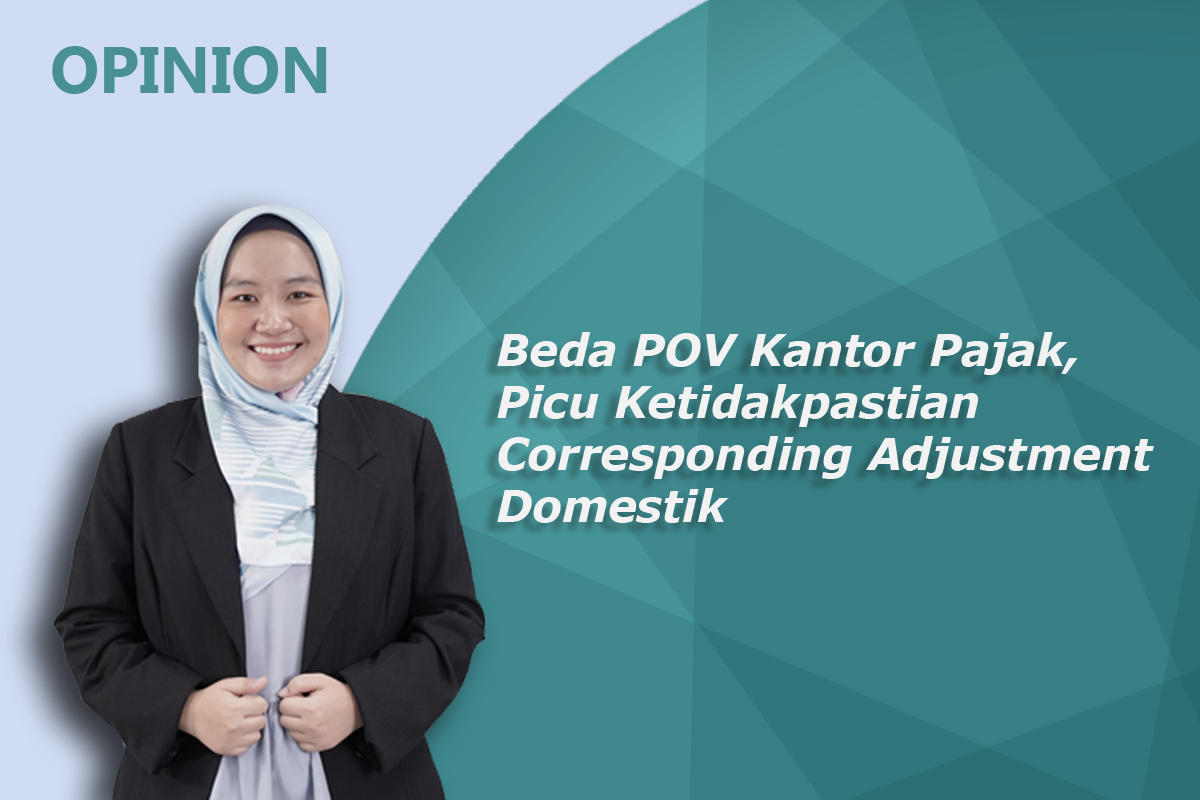Differing Tax Office Perspectives: Fueling Uncertainty in Domestic Corresponding Adjustments
Meiliana,
Friday, 05 July 2024

Transfer pricing disputes do not only arise from related-party transactions between companies in one group across jurisdictions. However, it can also occur between affiliated corporations that only have different domicile areas in the country.
Meanwhile, transfer pricing disputes arise due to adjustments by the Directorate General of Taxes (DGT), on transactions affected by special relationships. The reason is that the DGT considers that the transfer pricing price value does not fulfill the Arm's Length Principle (PKKU).
Two types of adjustments can be made by the tax authority. First, the Primary Adjustment is made when the difference arises, between the transfer price and the selling price or fair profit. Second, secondary adjustment, which is when the DGT determines the difference as a constructive dividend.
For the determination of the secondary adjustment, the business group may face the business group has the potential to face consequences in the form of the risk of double taxation.
Well, to eliminate double taxation due to domestic related-party transactions, it is necessary to conduct Domestic Corresponding Adjustment. Meanwhile, in general, the definition of Domestic Corresponding Adjustment is an adjustment of taxable income by DGT to transactions between domestic taxpayers and their
counterparties.
Read: Corresponding Adjustment, Anti Double Taxation that the Authority Ignored
Procedure and Legal Basis
Therefore, to avoid double taxation, it is necessary to conduct Domestic Corresponding Adjustment, the implementation of which is regulated in the Minister of Finance Regulation (PMK) Number 172 of 2023.
To be able to perform Domestic Corresponding Adjustment, the first step that a company must do is to submit a written notification to the tax office of the registered domestic counterparty
For example, company A domiciled in Location X has a related-party transaction with company B domiciled in Location Y. The first step in conducting Corresponding Adjustment is for Company B to submit a notification to Tax Office Y.
However, before submitting the application, it is essential to ensure that Company A has agreed to the primary adjustment determined and has not pursued any legal action.
Read: PMK 172/2023: Secondary Adjustment of Transfer Price Can Be Cancelled
International Best Practice
Basically, the regulation on Corresponding Adjustment issued by the government refers to The Organisation for Economic Co-operation and Development (OECD). Specifically, Article 9(2) of the OECD Model Tax Convention on Income and Capital (OECD Model).
This provision emphasizes the need for consultation between tax authorities to determine the Corresponding Adjustment. Thus, it can reduce the tax burden of related business entities, in one country if the income has been taxed in another country.
The consultation process can only occur through Mutual Agreement Procedures (MAP) according to Article 25 of the OECD Model. However, the OECD Model does not provide guidance on how Corresponding Adjustment should be applied to domestic transactions.
In India, transfer pricing regulations strictly prohibit Corresponding Adjustments for international transactions. This means that if an adjustment is made to the taxpayer's taxable income, India will not allow a Corresponding Adjustment to the taxable income of the counterparty.
While this rule does not automatically apply to domestic transactions, India does not yet have clear provisions on how Corresponding Adjustment can be applied to domestic transactions (Gaurav, 2013).
Meanwhile, the Greek government recently changed the regulations regarding Corresponding Adjustment, by issuing Law 4972/2022. This law allows transaction partners, to request a profit adjustment after a tax audit against the first taxpayer.
If the tax audit results in additional profits from domestic transactions between related parties, the counterparty may file an updated income tax return or restitution with the tax audit report. The restitution can be filed within three months after receiving the audit report.
The condition is that the taxpayer must first pay the tax arising from the profit adjustment in the transaction. The purpose is to obtain tax refunds or compensation.
Meanwhile, if the taxpayer files an objection to the tax assessment and receives a decision through administrative or legal procedures, the tax administration will adjust the profit of the relevant party in accordance with the decision (Perrou, 2023).
Read: PMK 172/2023 Details Industry Analysis Provision on PKKU
Practice in Indonesia
The problem is that although the regulation has been established, in practice, several obstacles make it difficult for taxpayers to conduct Domestic Corresponding Adjustments. First, the tax office may reject the Domestic Corresponding Adjustment due to the tax office's interest in meeting tax revenue targets."
The reason is that the provision of Domestic Corresponding Adjustment to the counterparty may reduce the profit. In the end, the amount of tax collected by the Tax Office can be reduced. Moreover, by regulation, the Tax Office is not bound by the obligation to approve the adjustment through the Corresponding Adjustment mechanism.
Second, taxpayers also face another risk: they cannot pursue other legal remedies when filing a Domestic Corresponding Adjustment. This restriction creates a dilemma, leaving taxpayers to choose between pursuing legal remedies or making adjustments through a Domestic Corresponding Adjustment.
Third, the regulation does not provide clear legal protection for taxpayers who file a Domestic Corresponding Adjustment, particularly concerning the possibility of future tax audits conducted by the DGT based on the agreement in the audit closing minutes. This includes the potential audit of the counterparty due to overpayments arising from the Domestic Corresponding Adjustment.
Fourth, the prevailing regulation also does not provide a time limit for DGT to give a decision on Corresponding Adjustment approval. Uncertainty regarding the decision deadline may affect the financial planning and business strategy of the taxpayers.
Fifth, the regulation of PMK Number 172 Year 2023 also does not provide a detailed explanation of the implementation of Domestic Corresponding Adjustment. Particularly, in the case of primary adjustment conducted in aggregation using the transactional net margin method. This raises questions about the criteria used to determine transaction partners that can apply for Domestic Corresponding Adjustment.
System Improvement and Service Standardization
The uncertainty arising from these issues reinforces taxpayers' hesitation to utilize the Domestic Corresponding Adjustment. In fact, Domestic Corresponding Adjustment not only serves as a facility for taxpayers but can also be an effective mechanism to reduce tax disputes at higher levels, namely objections and appeals.
Weaknesses that arise in the Domestic Corresponding Adjustment process should be addressed by establishing clearer and more detailed provisions. So that the regulation can provide legal certainty and in the end, Domestic Corresponding Adjustment becomes an attractive facility for taxpayers so that they do not hesitate to utilize it.
Another important note is that DGT should be able to guarantee and ensure that the response to the Domestic Corresponding Adjustment request at each Tax Office is consistent.
In the end, we hope that in the future, the Domestic Corresponding Adjustment process can be more reliable, and coordination between Tax Offices is better, without requiring formal submissions from taxpayers.
One solution to consider is the development of an integrated administration system or the collection of business group data under one Tax Office. Thus, the implementation of Domestic Corresponding Adjustment in Indonesia can be more effective, transparent, and able to run according to its purpose of reducing double taxation. (ASP/KEN)
Disclaimer! This article is a personal opinion and does not reflect the policies of the institution where the author works.


